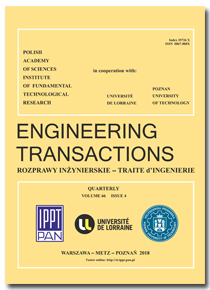10.24423/engtrans.3428.2025
Modeling of the Acoustic Properties of Foamed Polypropylene Panels
References
PN-EN ISO 10534-2:2003, Acoustics-Determination of Sound Absorption Coefficient and impedance in Impedance Tubes – Part 2: Transfer-Function Method.
PN-B-02151-2:2018-01, Building Acoustics-Protection against Noise in Buildings. Part 2: Requirements for Permissible Sound Levels in Rooms.
ASTM E1050, Standard Test Method for Impedance and Absorption of Acoustical Materials Using a Tube, Two Microphones and a Digital Frequency Analysis System, 2019.
Allard J.-F, Atalla N., Propagation of Sound in Porous Media: Modelling Sound Absorbing Materials, John Wiley & Sons, 2009, https://doi.org/10.1002/9780470747339.
Allard J.F., Champoux Y., New empirical equations for sound propagation in rigid frame fibrous materials, The Journal of the Acoustical Society of America, 91(6): 3346–3353, 1992, https://doi.org/10.1121/1.402824.
Arenas J.P., Crocker M.J., Recent trends in porous sound absorbing materials, Sound & Vibration, 44(7): 12–18, 2010.
Atalla N., Introduction to the numerical modeling and experimental characterization of porous materials, Public Technical Course, Graz, Austria, pages 1–2, 2014.
Batko W., Pawlik P., Wszołek G., Sensitivity analysis of the estimation of the single-number sound absorption evaluation index DLα, Archives of Acoustics, 42(4): 689–696, 2017, https://doi.org/10.1515/aoa20170071.
Cai Z., Li X., Gai X., Zhang B., Xing T., An empirical model to predict sound absorption ability of woven fabrics, Applied Acoustics, 170: 107483, 2020, https://doi.org/10.1016/j.apacoust.2020.107483.
Champoux Y., Allard J.-F., Dynamic tortuosity and bulk modulus in air-saturated porous media, Journal of Applied Physics, 70(4): 1975–1979, 1991, https://doi.org/10.1063/1.349482.
Delany M.E., Bazley E.N., Acoustical properties of fibrous absorbent materials, Applied Acoustics, 3(2): 105–116, 1970, https://doi.org/10.1016/0003-682X(70)90031-9.
Dev B., Rahman M.A., Repon M.R., Rahman M.M., Haji A., Nawab Y., Recent progress in thermal and acoustic properties of natural fiber reinforced polymer composites: preparation, characterization, and data analysis, Polymer Composites, 44(11): 7235–7297, 2023, https://doi.org/10.1002/pc.27633.
Egab L., Wang X., Fard M., Acoustical characterisation of porous sound absorbing materials: a review, International Journal of Vehicle Noise and Vibration, 10(1–2): 129–149, 2014, https://doi.org/10.1504/IJVNV.2014.059634.
Hirosawa K., Numerical study on the influence of fiber cross-sectional shapes on the sound absorption efficiency of fibrous porous materials, Applied Acoustics, 164: 107222, 2020, https://doi.org/10.1016/j.apacoust.2020.107222.
ASTM International, ASTM E2611-09, Standard Test Method for Measurement of Normal Incidence Sound Transmission of Acoustical Materials Based on the Transfer Matrix Method, ASTM, 2009.
Johnson D.L., Koplik J., Dashen R., Theory of dynamic permeability and tortuosity in fluid- saturated porous media, Journal of Fluid Mechanics, 176: 379–402, 1987, https://doi.org/10.1017/S0022112087000727.
Kino N., Further investigations of empirical improvements to the Johnson–Champoux–Allard model, Applied Acoustics, 96: 153–170, 2015, https://doi.org/10.1016/j.apacoust.2015.03.024.
Kino N., Ueno T., Improvements to the Johnson–Allard Model for rigid-framed fibrous materials, Applied Acoustics, 68(11–12): 1468–1484, 2007, https://doi.org/10.1016/j.apacoust.2006.07.005.
Kunio J., Yoo T., Jou K., Bolton J.S., Enok J., A comparison of two and four microphone standing wave tube procedures for estimating the normal incidence absorption coefficient, [in:] 38th International Congress and Exposition on Noise Control Engineering 2009 (INTER-NOISE 2009), Ottawa, Canada, Stuart Bolton J., Burroughs C., Gover B. [Eds.], pp. 1057–1065, Curran Associates, Inc., Red Hook, NY, 2010.
Liu X., Ma X., Yu C., Xin F., Sound absorption of porous materials perforated with holes having gradually varying radii, Aerospace Science and Technology, 120: 107229, 2022, https://doi.org/10.1016/j.ast.2021.107229.
Oliva D., Hongisto V., Sound absorption of porous materials – Accuracy of prediction methods, Applied Acoustics, 74(12): 1473–1479, 2013, https://doi.org/10.1016/j.apacoust.2013.06.004.
Olny X., Acoustic Absorption of Porous Media with Single and Double Porosity-Modeling and Experimental Solution [in French], PhD thesis, ENTPE-Institut National des Sciences Appliquées de Lyon, 281 p., 1999.
Olny X., Boutin C., Acoustic wave propagation in double porosity media, The Journal of the Acoustical Society of America, 114(1): 73–89, 2003, https://doi.org/10.1121/1.1534607.
Wu Q., Empirical relations between acoustical properties and flow resistivity of porous plastic open-cell foam, Applied Acoustics, 25(3): 141–148, 1988, https://doi.org/10.1016/0003682X(88)90090-4.
Sgard F.C., Olny X., Atalla N., Castel F., On the use of perforations to improve the sound absorption of porous materials, Applied Acoustics, 66(6): 625–651, 2005, https://doi.org/10.1016/j.apacoust.2004.09.008.
Whitley R.J., Hromadka II T.V., Theoretical developments in the complex variable boundary element method, Engineering Analysis with Boundary Elements, 30(12): 1020–1024, 2006, https://doi.org/10.1016/j.enganabound.2006.08.002.
Świrk P., Leniowska L., Korzyńska K., Acoustic properties of biodegradable materials in the low and medium frequency range, Vibrations in Physical Systems, 35(2): 2024209, 2024, https://doi.org/10.21008/j.0860-6897.2024.2.08.
DOI: 10.24423/engtrans.3428.2025





